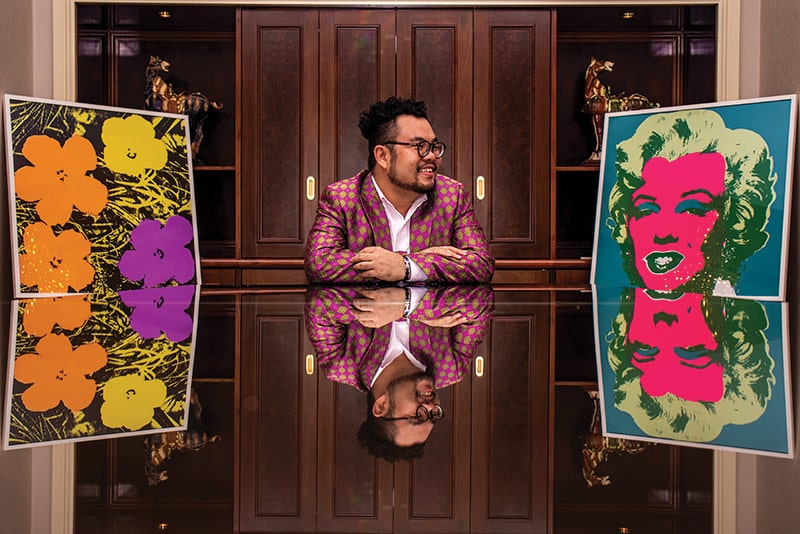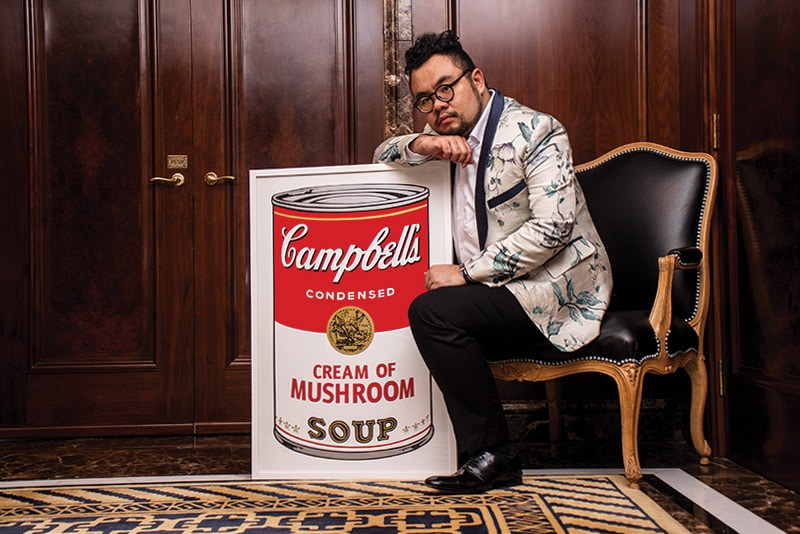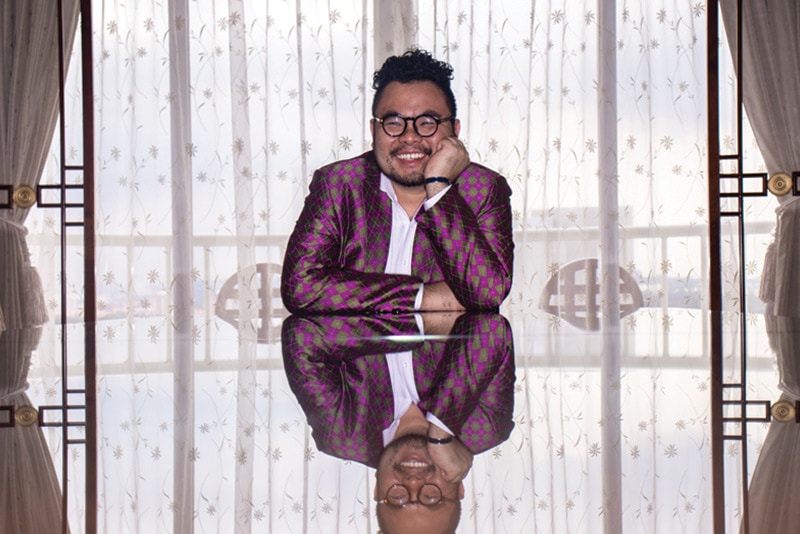Ryan Su: Making Art Accessible
What Makes Art, Art is a series that delves into some of art’s biggest questions and picks the minds of various individuals from the art industry to uncover diverse perspectives that stimulate, inspire, confront and even clash.
No one holds an art exhibition like Ryan Su. It was the start of 2016 when I found myself in a packed, vibrant room at Gillman Barracks. A record-breaking 2,000 visitors came on the first night of Andy Warhol: Social Circus (an exhibition organised by the 30-year-old lawyer under his non-profit, The Ryan Foundation), and I was one of them. The show, which exhibited the Pop Art icon’s polaroids, felt more like a party than anything else, rebelling against the sterile, all-white look of most galleries. Just when I thought it couldn’t get any crazier, a living, uncaged parrot appeared and swiftly made its way onto my arm.
The art world is often seen as inaccessible and pretentious, and it’s no surprise considering how galleries have stuck to the traditional mode of showing, serving their own industry instead of reaching out to the masses. Ryan’s exhibition, thus, comes as a breath of fresh air. Yet, while shaking the status quo, he’s also ruffled a few feathers, particularly that of industry purists who question his intention.
Fast forward two years, I’m finally meeting the man behind the magic. Strolling into the glitzy Shangri-La Hotel lobby, the young art collector is dressed down with a pair of neon green Birkenstock sandals. Despite his flamboyant appearance and reputation, he speaks in a gentle, mellifluous voice, sharing his take on the state of the local art scene and how art can be for everyone.
High Net Worth: Have you always been exposed to art?
Ryan Su: I was always attracted to colour and beautiful things. When I was about seven, I took part in art competitions and actually won prizes. They were neighbourhood competitions, where we drew in crayons. I never won first place though, which made me feel very discouraged. I got second and third. In school, I always got an A for art. It was my favourite subject. But I did not want to become an artist. It was not my dream. Later on, I went to law school and there was a time when I was on an exchange programme in England. The school there was very boring. I decided to leave and study at an auction house instead. What I studied at the auction house was art law.
I made friends with some of my lecturers, who were lawyers working in London. A lot of the artists there don’t have money, so if they go to the lawyers, they can’t pay money for their legal services. Instead, they gave artworks to their lawyers. I thought, if I did art law, I could not only help people, but also have this wonderful gift of artworks.
How did you get into law?
I went into law really by chance. At that time, I was interested in landscape architecture. I had a big collection of plants and flowers, and started designing other people’s gardens. There was a particular project I did where I wasn’t paid for my services. I filed a claim at The Small Claims Tribunals against the person who didn’t pay me, and I won. I was 16 or 17 years old, and I thought I could be good at this. I just randomly said I wanted SMU Law. I knew nothing about law. At the interview, I just talked and talked, and I got in! [laughs] So before I collected art, I was collecting plants, flowers and parrots. I’ve always had this collecting gene in me.
Is your family into collecting things as well?
I have a grandfather who collected all kinds of birds. When I was young, he would give me birds, to my parents’ disdain. I also had this big aquarium in my house, and my other set of grandparents would give me fish. I don’t know what kind of fish they were, but I was reading about them. I was also reading these university textbooks and reference books at the age of 10. That was what I liked.
So you enjoy learning.
About birds and plants, so art came very naturally because art requires a lot of research—and it’s the same with law. Since I was young, I was unintimidated. I was weird and curious.
What goes into the research for art?
Books, the Internet. A lot of stuff is not on the Internet because all these people existed in the pre-Internet age, so research takes a lot of time. If they’re alive, I’d want to know them. To appreciate an artist, it’s 99% research. The easiest way to do this is to go to a show and find out about the artist’s life. Everyone is interested in other people’s lives. It’s why people watch The Real Housewives. It’s the same with artists. Find out about their lives and you’ll be interested.
Is your entire art collection kept in storage, or do you decorate your home with a few pieces?
In Singapore, the climate is not good for the paintings to be exposed, so they are all stored in the warehouse. If you take them out, they will start having spots, which are actually a kind of fungus. Then, the value drops and you’ll have problems fixing it.
Does that mean you have to go to the warehouse to appreciate and enjoy the art pieces?
Yes, and that’s why The Ryan Foundation has exhibitions every year. We took a huge risk, especially with the first exhibition with Andy Warhol, because we showed his polaroid photographs. They need to kept in 100% darkness and in very low humidity. Any exposure to light will result in fading. For us to put it under air-conditioning at Gillman Barracks wasn’t great. We also know that if you keep art in storage and nobody sees it, it doesn’t serve any purpose, so we took the polaroids out for people to see for a month.
Speaking of The Ryan Foundation, how did it come about?
I started it as a joke. I said, let’s donate $10 to something and just call it The Ryan Foundation instead of having all the art in the warehouse. We weren’t serious. When I started the foundation in 2012, it was also a situation where I had collected a lot of art, and I thought, where is the end point? Why am I buying so much art and dumping them in a warehouse, never to be seen again? So I said, okay, art is something that’s created by society, so it should be shared with society. We decided to organise an exhibition every year to promote art awareness in Singapore. We take from our collection, and borrow from other institutions, galleries and collectors to make the exhibitions whole. That was how the Andy Warhol exhibition came about.
I feel that it’s very hard to see Western art in Singapore—and I say Western, as in the particular Euro-American narrative. The narrative of art that people see here is always very Southeast Asian or Singaporean, but a lot of these artists train in Europe. It’s like Georgette Chen. Her paintings didn’t just appear looking like this from outer space. She lived in Paris and learnt from the people. However, the narratives seem to focus on the work she’s created, rather than her inspirations. I’m trying to open people’s minds up to contemporary art and these artists’ inspirations and influences. Since our collection started in the West, it’s Western art-based.
What’s the story behind these artworks you’ve selected to shoot with? What did these particular pieces teach you about Andy Warhol?
These silkscreens behind me are by Sunday B. Morning, and it’s interesting because Andy Warhol created the exact same pictures. Andy Warhol always believed in the commercialisation of art, the reproducibility of art. The story goes that he gave his silkscreens to an artist and told him to do whatever he wanted with them. He gave the artist the colour combinations as well. So this artist, Sunday B. Morning, started producing works in exactly the same screens and the same colours as Andy Warhol, who treated the whole thing as a joke. He would sign behind some of the paintings, ‘This is not a Warhol’.
Are these silkscreens signed with, “This is not a Warhol”?
No, but this is very interesting. The artist that he gave those screens to also had a special stamp, which said, ‘Put your own signature here’. Once you buy it, you can just sign it. That’s the whole idea. It’s beyond a visual piece of art. It becomes conceptual—the concept that art is meant to be reproduced and shared. What is the value of art? This looks exactly the same as the one by Andy Warhol, but Warhol’s could be worth millions, while this could be worth a couple hundred dollars. They are not original Warhols, but they were made with the original materials, so it questions this whole concept of originality. They’re not fakes. They also have some value.
What determines the value of art?
A lot of factors. If you ask an economist, they will tell you it’s scarcity that determines the value of art, the rarity of something. To avoid going into a very long discussion, I think the value of art is determined by the demand for it and the people who are willing to pay the price. You might think, this painting is just one solid colour. Why is it $30 million? It didn’t get to be $30 million right away. It probably started at $10 million. There were people who competed with each other to bring the price all the way up to $30 million. Demand drives the price up. That’s the easiest way to understand it.
Where does the demand come from?
Traditionally, the demand came from how important a work is in an art historical context. For example, this was the first painting that was ever created in this method. Therefore, it is very important. Usually, when paintings have this kind of significance, the museum will collect it. When the museum collects it, private individuals will also want it in their homes, and they’ll go find it. That’s how the demand slowly builds.
Is a piece of art almost like a status symbol?
For some people, it is. There are people with that kind of mindset, people who say they must have a Picasso in their house, even if it’s a very lousy Picasso. Picasso lived a long time. He produced good works and bad works. To someone who knows what a Picasso is about, not every Picasso is a good one. There were times when Picasso was poor, so he would just make paintings to get money, and those were not the good ones.
What does a bad Picasso look like?
I don’t know. I don’t collect in this group. The group that I collect is generally in the category called post-war contemporary, which is after 1945.
What drew you to this period of art?
It’s a reflection of the times now. A lot of these artists are still alive and making things. People confuse modern art with contemporary art. Modern art is art created before 1945. Contemporary art is called contemporary because it’s created in the contemporary era by our contemporaries. Another interesting thing is that contemporary artists are generally cheaper than other types and classes of art, which have a more established demand.
Aesthetically speaking, what are you drawn to?
I’m drawn to colour like all the things I’ve collected and even in my dressing.
So you’ve never had a strong reaction to, say, an all-black painting?
But there’s also beauty in that. Right now, I’m doing my PhD in art and cultural property law at the School of Art, Design and Media at NTU, so I know the historical significance of works. That gives me an appreciation of works that may not be directly attractive.
What about the uninitiated who lack that kind of context and knowledge? How can they learn to love art?
They can go to art exhibitions. We have an upcoming exhibition (Lucy Liu and Shubigi Rao: Unhomed Belongings) in January, which features two strong artists who happen to be Asian women from different parts of the world. They are contemporary artists—one lives in the West, one lives in the East. But whether you live in the West or East, would your thinking or psychological state be Western or Eastern? We don’t know. They’ve never met and they’re working together for the first time. Their works will be presented as a dialogue that brings to the fore ideas in contemporary art, and contemporary issues like identity, culture, race and relationships. I find it very exciting to see things like that and perhaps people can relate to it.
Through this exhibition, we want to get people who generally don’t go for art events to come. I want it to be an entry point to contemporary art, which can be very intimidating. You go into a gallery, where it’s all white walls and you don’t know what you’re looking at.
“There are a lot of art events, but they’re inviting the same crowd. I feel that there has been little success in reaching out to new groups of people who don’t know anything about art.”
Have you ever felt intimidated going into a gallery?
At the start. And those were not good galleries at all. What they were selling was crap. In retrospect, I thought those were the finest, most chic things you could buy. The best galleries are not intimidating.
We want people to be involved. I think this is lacking in the art scene now. There are a lot of art events, but they’re inviting the same crowd. I feel that there has been little success in reaching out to new groups of people who don’t know anything about art. When I was in school, the art class was always replaced with a Chinese or Maths class, or perhaps the art teacher was the Chinese teacher. Nobody cares. The state of arts education isn’t great, and we need more efforts besides the education system to reach out to people.
The way art classes are taught in primary and secondary schools needs to change too, especially with the grading system.
Why are you giving them grades? If someone colours the whole paper black, does the person get a D? No! Maybe the person is a genius. There must be other ways of recognising different kinds of art. Maybe the child is a conceptual artist. You don’t know this. Our art class is also basically art making. They give you potatoes and you make prints out of them. There needs to be more about the theory of art, art history, where these great artists come from. We didn’t learn about the life of Picasso and all his mistresses. We didn’t learn about the life of Vincent Van Gogh. Why was he poor? What happened to him? Why was he only successful later? This would give people insights about their own lives and about how art can be integrated with life.
Do you think appreciating art is an intellectual affair?
It can be intellectual or non-intellectual. If you’re a non-intellectual person, you’ll enjoy art for its colour—that’s the most primal and basic thing. You can be extremely intellectual and you’ll still enjoy it for different values and its position in art history. I think art… there are no words. You can make what you want out of it. It even depends on your state of mind. You may go to a museum one day, feeling very tired, and just walk around aimlessly. If you go on another day when you’re not tired, you may start making all these connections, reading all the materials, and have a different experience.
What makes art, art?
The art historical context, and with that comes the demand for it, whether museums and institutions are showing it, whether collectors are buying it. It’s a whole system, and a lot of people need to understand that there actually is a system. Singapore needs to understand this system in terms of trying to create a vibrant art scene.
What is the best way to reach out to the masses?
To have shows that are accessible. I’m not beyond giving free stuff to get people in. A lot of people judge us. If they don’t like it, at least they tried. If they like it, then move on to the next step.
Is it too much of a stretch to organise a show at a pasar malam (night market)?
Oh, we actually plan very edgy shows. It’s just that I can’t share my ideas now. We actually are kind of crazy. We don’t care. I’m not doing it just for the sake of it, just to attract people. It must be good stuff with a rigorous context, and you can present it in an unexpected way to produce a good show.





